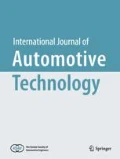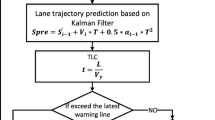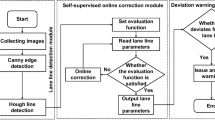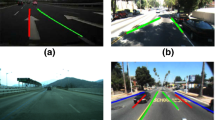Abstract
Lane-changing of surrounding vehicles is a risky situation because vehicle accidents can be easily caused by driver’s unawareness of the surrounding vehicle. Much research has conducted on lane-change recognition (LCR) to avoid these vehicle accidents by warning drivers. LCR is a technology to estimate lane-changing behaviors of surrounding vehicles from observation data: position, velocity, and lane information. Since these observation data change continuously during lanechanging, most research for LCR has used time series data based on hidden Markov model (HMM). A challenging point of LCR is that HMM could make false positives in LCR when the observation data include uncertainties such as sensor noise and object detection error. Previous research has tried to process observation data by using Bayesian filter. However, the approach cannot remove all data uncertainties. This paper proposes a method for using observation uncertainty through an adaptive HMM for LCR. In the method, HMM models are modified in real time based on data covariance to filter data with high uncertainty. For evaluation of the algorithm, it was tested through 71 lane-changing cases in real driving situations. The results show that the proposed method enhanced the recognition accuracy by 25.3 % (63.3 % → 88.7 %) than a previous LCR method.
Similar content being viewed by others
References
Bener, A., Yildirim, E., Özkan, T. and Lajunen, T. (2017). Driver sleepiness, fatigue, careless behavior and risk of motor vehicle crash and injury: Population based case and control study. J. Traffic and Transportation Engineering (English Edition), 45, 496–502.
Bilmes, J. A. (1998). A gentle tutorial of the EM algorithm and its application to parameter estimation for Gaussian mixture and hidden Markov models. Int. Computer Science Institute, 4510, 1–13.
Jang, C. H., Kim, C. S., Jo, K. C. and Sunwoo, M. (2017). Design factor optimization of 3D flash lidar sensor based on geometrical model for automated vehicle and advanced driver assistance system applications. Int. J. Automotive Technology, 181, 147–156.
Jo, K., Lee, M., Kim, J. and Sunwoo, M. (2017). Tracking and behavior reasoning of moving vehicles based on roadway geometry constraints. IEEE Trans. Intelligent Transportation Systems, 182, 460–476.
Kuge, N., Yamamura, T., Shimoyama, O. and Liu, A. (2000). A driver behavior recognition method based on a driver model framework. SAE Paper No. 2000-01-0349.
Kumar, P., Perrollaz, M., Lefevre, S. and Laugier, C. (2013). Learning-based approach for online lane change intention prediction. Proc. IEEE Intelligent Vehicles Symp. (IV), Gold Coast, Queensland, Australia.
Laugier, C., Paromtchik, I. E., Perrollaz, M., Yong, M., Yoder, J.-D., Tay, C., Mekhnacha, K. and Nègre, A. (2011). Probabilistic analysis of dynamic scenes and collision risks assessment to improve driving safety. IEEE Intelligent Transportation Systems Magazine, 34, 4–19.
Liu, P., Kurt, A., Redmill, K. and Ozguner, U. (2015). Classification of Highway Lane Change Behavior to Detect Dangerous Cut-in Maneuvers. The Transportation Research Board (TRB) 95th Annual Meeting.
Mandalia, H. M. and Salvucci, M. D. D. (2005). Using support vector machines for lane-change detection. Proc. Human Factors and Ergonomics Society Annual Meeting 49, 22, 1965–1969.
Mesures, B. I. D. P. E., Internationale, C. É. and Normalisation, O. I. D. (1995). Guide to the Expression of Uncertainty in Measurement. International Organization for Standardization.
Nishiwaki, Y., Miyajima, C., Kitaoka, N. and Takeda, K. (2012). A Stochastic Approach for Modeling Lane-Change Trajectories. Digital Signal Processing for In-Vehicle Systems and Safety. Springer. New York, USA.
Rabiner, L. R. (1989). A tutorial on hidden Markov models and selected applications in speech recognition. Proc. IEEE, 772, 257–286.
Schlechtriemen, J., Wedel, A., Hillenbrand, J., Breuel, G. and Kuhnert, K.-D. (2014). A lane change detection approach using feature ranking with maximized predictive power. IEEE Intelligent Vehicles Symp. Proc., Dearborn, Michigan, USA.
Streubel, T. and Hoffmann, K. H. (2014). Prediction of driver intended path at intersections. IEEE Intelligent Vehicles Symp. Proc., Dearborn, Michigan, USA.
Tang, B., Khokhar, S. and Gupta, R. (2015). Turn prediction at generalized intersections. Proc. IEEE Intelligent Vehicles Symp. (IV), Seoul, Korea.
White, G. H. (2008). Basics of estimating measurement uncertainty. The Clinical Biochemist Reviews 29, Supplement 1, S53.
Woo, H., Ji, Y., Kono, H., Tamura, Y., Yamashita, A. and Asama, H. (2015). Detection method of lane change intentions in other drivers using hidden markov models. Int. Conf. Advanced Mechatronics: Toward Evolutionary Fusion of IT and Mechatronics, 253–254.
Author information
Authors and Affiliations
Corresponding author
Rights and permissions
About this article
Cite this article
Park, S., Lim, W. & Sunwoo, M. Robust Lane-Change Recognition Based on An Adaptive Hidden Markov Model Using Measurement Uncertainty. Int.J Automot. Technol. 20, 255–263 (2019). https://doi.org/10.1007/s12239-019-0025-8
Received:
Revised:
Accepted:
Published:
Issue Date:
DOI: https://doi.org/10.1007/s12239-019-0025-8




